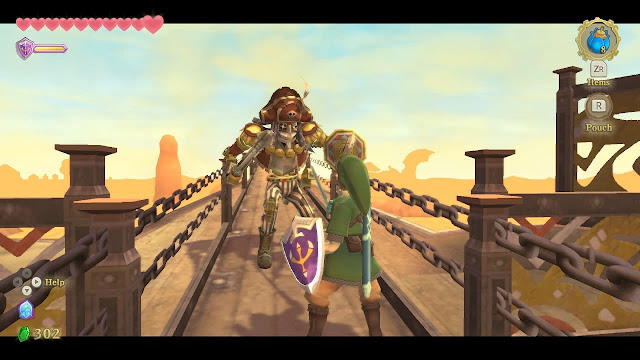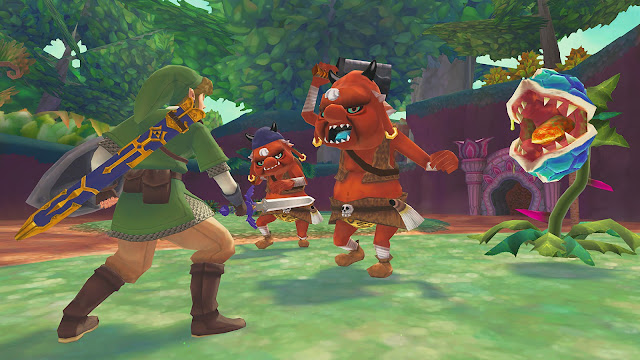Here we have it: the least of the Zelda series, a decade later, remastered. Of course, when I talk about “the least” of the Zelda series I am referring to a series that is arguably the most lauded and celebrated of all, and being the “least” of that series is still better than being the best of just about every other property. Nonetheless, Skyward Sword is the least, and unfortunately, this HD remaster doesn’t do anything meaningful to address that.
Why Skyward Sword does really well is tell a story. According to the chronology of the entire Zelda series, this is actually the first, and takes us right back to the origins of Zelda, Link, and explains why they keep showing up, time after time, across aeons. What I love about it is that even though it does take place in the present tense, actually playing it feels like reciting a legendary poem, or watching cave paintings come to life in front of you. Even by the standards of the story-efficient Zelda series Skyward Sword is a straightforward affair, but then so was the likes of Beowulf and, deliberately or otherwise, it does seem that Nintendo has borrowed heavily from these particular storytelling traditions.
This efficiency comes across in the level and world design too. In fact, a lot has changed in the ten years since Skyward Sword seemed to tell an epic story of worlds above and below, and now it all comes across as positively tiny in scope. Each of the spaces that you explore is filled with things to do, the dungeons feature the same layered, puzzle-filled puzzle box experiences, and the village in the sky is the same quirky location that we’ve always loved in the Zelda series, but in comparison to what Nintendo would later achieve with Breath of the Wild, it now feels small and, technically, a product of its time. No amount of HD sheen can paper over that. And yet, at the same time, I actually enjoyed that. The narrower focus in the setting kept the action moving forward, and again fit with the singularly focused nature of most epic poems and legends.
Skyward Sword’s more narrow spaces also means that the game’s world is filled with things to do. You can’t go a dozen steps without having a tightrope to acrobat across, enemies to fight, little treasures kept just out of reach to puzzle out, or “hidden” areas that you will make a mental note to return to down the track once you have the right item to solve the trick. Conversely, though, the game’s intense use of space also means that when it decides to chew up time, you feel something important coming. I’ll give you an early example; the first time you descend to the land below, you’re at the top of a big cavern, with a winding path down to the base (where you see some ominous black smoke rising). You can leap down there and use a sail to land safely quickly, or you can do what I did and run the whole, winding way down. It takes a solid few minutes and there’s a rising intensity knowing that this was an important moment coming up. When Nintendo is at its best, it plays with space and pacing in a masterful way, and Skyward Sword is, frequently, Nintendo at its best.
Another good reason to go back and give Skyward Sword another spin is to see just how much it influenced the subsequent Breath of the Wild. Many of the qualities that people love from Breath of Wild are in there – the flexible way to solve some challenges, the ability for the AI to surprise and delight, the good use of an endurance meter to facilitate, rather than limit, exploration. It’s often in prototype form, yes, but the lineage and iteration is there. Even the endurance of equipment is a factor, though thankfully in that case the relatively primitive implementation in Skyward Sword is to its advantage – Link’s sword endures through everything, it’s just his shield that you need to baby through breakages here. In fact, with hindsight being everything, Skyward Sword as a bold new direction for Zelda makes sense when you realise that it cumulated with Breath of the Wild. Twilight Princess was everything that Nintendo could do to push the thematic and aesthetic qualities of Ocarina of Time and Skyward Sword was the next generation. All of this becomes so much clearer when you can play it now and look at it in context of what came before and after.
None of this is to say there aren’t issues, and I do think that Skyward Sword is aging less gracefully than Ocarina of Time, Majora’s Mask, Wind Waker and Twilight Princess. Part of the problem is the motion controls, and I’ve done a separate video to discuss my issues with those, but here I’ll say that they’ve always been divisive, and I’ve always sat on the side that wasn’t enamoured by them, but as time has gone on the superficiality of those motion controls is becoming more and more clear. There is nothing in Skyward Sword that couldn’t have been just as exhilarating with buttons. Breath of the Wild proved that itself. Another issue is despite the intense layouts of the environment, there’s an excess of padding and a little too much “play fetch” to stretch what really would have been ideal at a “snappy” 20 hours into something that feels draining by the end at 30+ hours. From a purely pragmatic perspective, this was probably Nintendo’s solution to providing an epic-length action-adventure experience on the diminutive Wii hardware, but previous titles were more comfortable being efficient and this does stand out.
I’m also vexed that Nintendo would lock instant fast travel behind an Amiibo. That’s a genuine quality of life improvement that would have assisted players – particularly those that find themselves struggling deep in a dungeon and in need of help the most – and Nintendo knows exactly what it was doing there. I’m surprised they didn’t stick the autosave (the very welcome autosave) behind a separate Amiibo. That Amiibo feature doesn’t break the game if you go without it, since it wasn’t part of the original Skyward Sword, but it does come across as very exploitative for the way that it addresses a piece of feedback that I’m sure Nintendo heard a lot of.
The Zelda series has moved through a number of different narrative genres and thematic cores over the years. Some are dark or abstract. Others aim to be more high fantasy or whimsical. Some are grand adventures while others are more focused. Skyward Sword has always sat a little apart from the others, because while all other Zelda games give the impression that you’re experiencing current events through your Link-avatar, Skyward Sword instead leaves the impression that you’re witnessing the retelling of a great legend of antiquity. As such there’s a primeval quality to it that informs its beautiful aesthetic and gives it a wonderful and different sense of adventure. I might have issues with the motion controls (let alone the sub-standard effort that Nintendo made to implement button controls), but nothing can detract from the core quality of this wonderful adventure.
– Matt S.
Editor-in-Chief
Find me on Twitter: @mattsainsb










